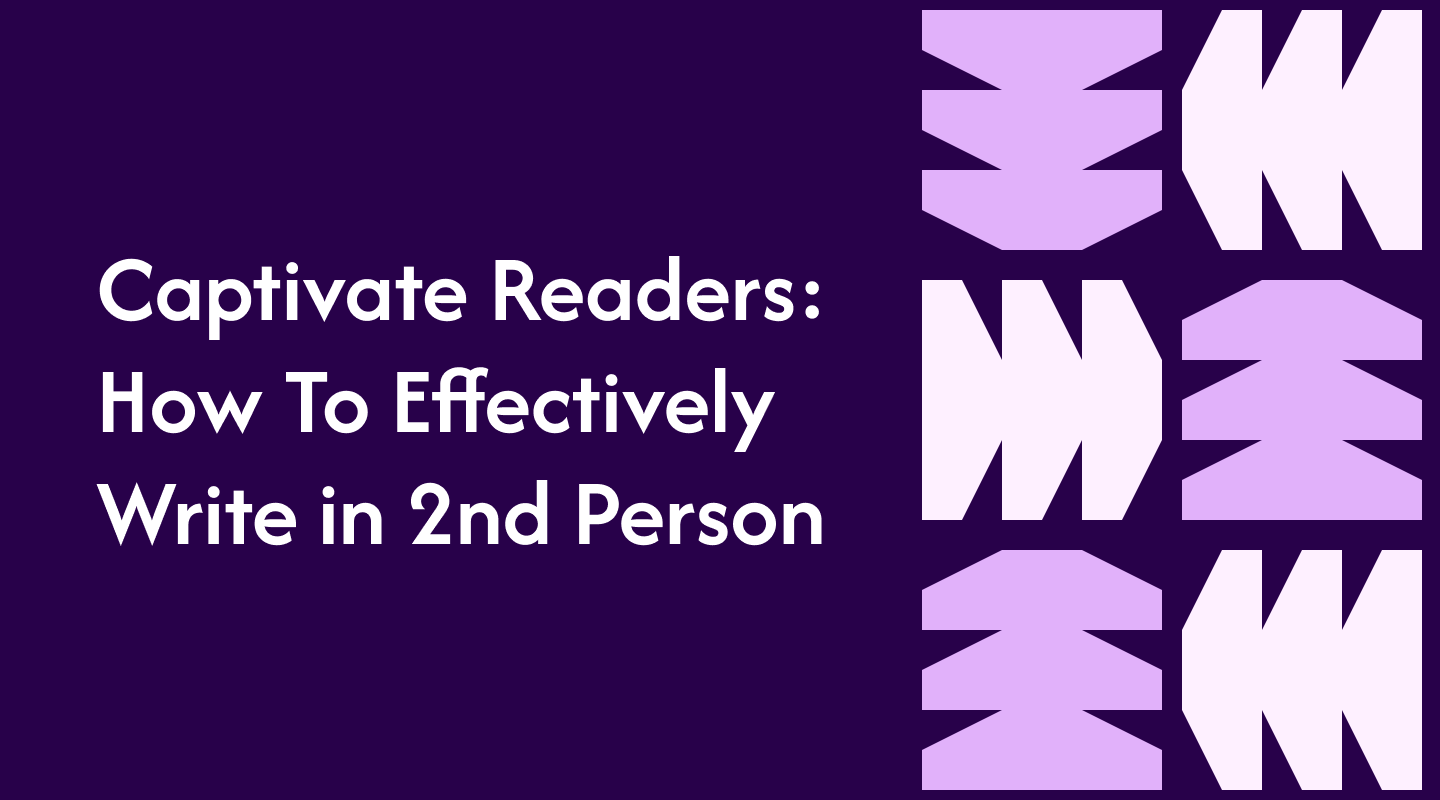Want to make your readers the star of the story? Writing in the second person (“you”) places them directly in the center of the action, creating an immersive and engaging experience. This guide explores how to effectively use “you” consistently, harness the active voice and present tense, and tap into the reader’s senses and emotions to craft compelling narratives. Discover how to master this powerful perspective and bring your stories to life.
Key Takeaways
- Writing in second person means you’re directly addressing your reader with “you,” which creates a tight, personal bond. This technique immerses readers in the story and puts them in direct connection with the action.
- Second person places you directly in the action. This method opens the door to immersive storytelling and impactful emotional resonance.
- This approach is effective for narrative nonfiction or immersive fiction, or in short form pieces where building a sense of place and emotional resonance is the key.
- Writers need to maintain their readers’ interest by changing things up. They too must avoid overusing “you” to prevent reader fatigue and to keep a fluid narrative.
- Second person works best in poetry, advertising, and how-to material. It makes the message more human and – just like you – more relatable.
- Try your hand at short stories or flash fiction to hone your second person writing talents. You’ll develop your craft and discover its artistic possibilities!
What Is Second Person Perspective?
The second person perspective is a unique narrative style that speaks to the reader directly with the use of the pronoun “you.” This method puts the reader right in the action. It allows them to engage with the narrative or text.
It’s easy to see why the reader quickly finds herself at the heart of the action. They feel the story happening around them, as opposed to simply seeing it from the outside. This point of view adds a surprising level of intimacy and urgency. It accomplishes a great feat by connecting the text to the reader.
How Second Person Differs from Others
The first person perspective is the use of “I” to provide an inside look or personal experience, while the third person perspective is the use of “he,” “she,” or “they” for an outside narration. In opposition, the second person perspective involves the reader firsthand.
By directly addressing the audience as “you,” this perspective eliminates the position of the passive observer. The second person might say, “You walked into the room.” Instead, the third person would say, “She entered the room.” In response, the second person announces, “You enter the room.
The tactile nature of this hands-on engagement is what makes the experience so different. It’s almost like the narrative knows what you’re thinking and feeling, drawing you further into its immersive world.
Second person perspective provides unique narrative experiences that are rich and rewarding. It gives writers the opportunity to create stories in which a reader isn’t merely observing action but actively involved in it.
For instance, in interactive fiction or choose-your-own-adventure books, “you” becomes the protagonist, making choices and facing consequences within the story. This approach isn’t just for fiction. In nonfiction, it enlivens memoirs, critiques, personal essays, how-tos, and self-help books.
It turns nebulous guidance into a clarion call for urgency and action.
When to Use Second Person
Second person is not for everyone, but under the right context, it’s a lovely and impactful device. Personal essays are a natural form for its skill at creating a close bond, such as directly addressing the reader’s life.
Short stories and flash fiction shine in the second person. This perspective packs a truly great wallop of engagement, and the shortness adds a level of intensity that’s palpable to readers. Immersive fiction has a profound potential. Its aim is to inspire, provoke and entertain with bold ideas.
This second person perspective closes the distance between the writer and reader, inviting readers to develop a sense of empathy and understanding. It requires thoughtful implementation.
Though it immerses its readers, putting them in the immediate action of the narrative, it can be harsh. A good second person narrative puts you in unfamiliar situations.
Surrounding yourself with this kind of energy, you’re bound to have experiences that are new, inspiring, and life-changing.
Why Choose Second Person Writing?
Second-person writing provides a unique, immersive experience that can make your content more impactful by breaking the fourth wall and speaking directly to the reader. It makes the reading experience much more personal and therefore creates a deeper connection between the writer and the reader.
Putting the reader in the middle of the story creates an emotional connection. Second person opens up a world of fun, inventive, expressive narrative potential.
Engage Readers with Direct Address
Using direct address where appropriate in second-person writing draws readers in and encourages them to become active participants in the narrative plot. By using the word “you,” the story instantly brings readers in, creating a sense of personal investment.
Write in second person to draw a reader in, by example, “You step into the shadowy chamber, pulse pounding at what you cannot see.” By using this method, it adds to the overall immediacy of the piece, making it feel like the reader is experiencing that moment in real time.
Relatable, real-life scenarios make this personal connection even stronger. Imagine the opening line, “You know the drill, sitting in front of the empty screen, waiting for your muse to strike you.” Those moments ring true because they reflect the lived experience of many of us.
An informal tone, similar to discussing ideas with a close companion, makes the writing more inclusive and captivating. This strategy puts the reader in the role of an actor instead of a spectator.
Create Unique Emotional Impact
Second-person storytelling is uniquely capable of driving an emotional gut-punch by putting readers in the thick of the story and the peril. Narrative lines like, “You touch the cold metal to your skin,” immediately pull people in.
Using sensory details enhances that effect even further, bringing the whole scene to life in a clear, memorable way. In addition to opening up more emotional avenues, second-person writing creates an opportunity for self-reflection.
When you start to second guess your decisions, you start to think you should have done more. Each of these phrases invites you to consider the emotions of the story and relate the narrative to your life.
Explore Creative Possibilities
Second-person writing invites more experimental approaches to narrative. Writers can push boundaries and play with genre, whether it be dystopian fiction or instructional narrative, providing new life and lenses to familiar genres.
For example, a mystery novel could guide readers through solving the case themselves: “You find the note tucked under the desk, the handwriting unfamiliar.” This perspective gives writers the opportunity to subvert expectations, creating a story that feels surprising and engaging.
It gives students a really powerful tool to explore themes of identity, introspection, self-reflection. Questions such as, “You’ve spent decades crafting this persona, but is it actually you?” invite serious soul-searching on the part of readers.
They challenge us to reflect on real life and deepen the narrative with nuance and complexity.
Advantages of Writing in Second Person
Writing in the second person provides you with an unparalleled perspective. Perhaps most importantly, it immerses you in an almost 1:1 way by putting YOU in the middle of the action. This technique builds a powerful relationship, encourages a deeper sense of immersion, and offers exciting creative opportunities to authors.
An added benefit of writing in second person is the sense of urgency and drama it creates by confronting readers directly as “you”—it’s a visceral, personal, energizing experience.
1. Build Strong Reader Connection
Writing in the second person creates a unique, immediate connection to the reader. By writing directly to them, you add a level of immediacy and intimacy that brings them into the story.
Picture yourself coming in from the cold after a long day. That emotion is what makes us feel connected right away, because it taps into something we’ve all felt. It’s this perspective that makes the case both urgent and compelling.
It maintains that reader’s tension by making them a part of the story as it develops around them.
FREE GUIDE
Avoid these AI words to make your content sound more human


2. Enhance Immersive Storytelling
This is where descriptive language becomes vital to successful second-person storytelling. Rather than just watching, readers experience the scene as if they are present.
Imagine, “You feel the crackle of leaves beneath your feet as the crisp autumn air kisses your cheek.” These types of vivid, concrete descriptions drop readers directly into the action, deepening their sensory engagement with the story.
With beautifully cinematic pacing, always using rhythm to show how the story should unfold, it creates a page-turner that’s difficult to stop reading.
3. Experiment with Narrative Style
One of the benefits of writing in second-person is that it challenges writers to step outside normative frameworks. It dares you to experiment with length and cadence, building an evocative texture of ups and downs.
To illustrate, punchy short sentences create a sense of urgency, whereas longer sentences may create a sense of contemplation. When you incorporate internal monologue or dialogue, you add layers to the narrative, providing depth and multiple points of view that hook the reader.
4. Effective in Poetry and Advertising
Second person can be very effective in poetry and advertisement. Its power to stir passion and paint a picture in the reader’s mind makes it the ideal form for poetry.
In advertising, it creates a deeply personal, human connection. For example, “You owe it to yourself to indulge” uses second person to talk straight to the reader, making the message personal and powerful.
This tactic further builds credibility and rapport, which is particularly important when penning copy directed at consumers.
Disadvantages of Second Person Writing
Though second-person writing can provide an intimate and captivating perspective, there are significant drawbacks that can undermine the approach. These drawbacks mostly stem from its unique format, which might be a turn off for some readers. By being aware of these disadvantages, writers can better decide when and how to incorporate this point of view.
1. Limit Reader’s Interpretive Freedom
One of the biggest disadvantages of second person writing is that it usually keeps the reader’s attention squarely on the “you” in question. This can limit the interpretive scope, since audiences might find it difficult to navigate motivations and feelings beyond the story’s prescribed course.
In a narrative where “you” are the narrative’s focus, it’s difficult to understand what the other characters might actually feel like. Their inner demons and other perspectives are frequently pushed to the background. That intense second person concentration can overwhelm the narrative in a way that makes it difficult, if not impossible, to introduce layers or a subplot.
Crafting second person Tying second person to moments that promote personal reflection can go a long way toward ensuring we make folks feel included, not limited.
2. Risk of Overusing “You”
The constant barrage of “you” gets tiresome after a while, leading to reader burnout. This is most apparent in longer stretches, where the second-person, more chatty style may seem awkward or disingenuous.
For example, a paragraph full of sentences that start with “you” could turn readers off. Mixing up sentence lengths and adding colorful adjectives will go a long way towards keeping readers engaged.
Careful editing is important to make sure the narrative still reads fluidly without calling too much attention to the pronoun.
3. Challenges in Fictional Writing
Building a cast of emotionally rich, complex characters in second-person fiction is a challenge as well. This narrative POV tends to make the reader the protagonist, which can be daunting or forced.
For instance, readers may experience the sensation of being marionettes, being led on without any power to influence the story. Creating subplots or secondary characters is difficult, since the perspective is so tightly locked on “you.
Writers can surmount this by making sure that even if the story’s high concept is complex, the emotional arc—which is ultimately what audiences will connect with—is universal.
Tips for Writing in Second Person
Writing in the second person speaks directly to your readers. By taking this approach, you open up a more immersive and personal experience for them. This second-person point of view shatters the fourth wall, inviting readers into the story as engaged players.
It just takes some finesse in execution to keep it impactful and not run it into the ground. Here are some tips to help you adjust your strategy and make your second-person writing more effective.
1. Use Present Tense for Impact
The present tense allows for more immediacy in second-person writing, immersing the reader in the experience as it’s happening. It makes it an immediate and thrilling experience, like the events are happening as you watch them.
So instead of writing, “You might have entered the room,” write, “You enter the room.” Consistency is important. Changing from one tense to another can disorient your reader.
Using present tense increases emotional stakes too, so the story feels more immediate and relatable.
2. Avoid Repetition of “You”
Overdoing it on “you” can lead to a toothless, awkward, overly-repetitive, or even confusing read. Change up the syntax to maintain the prose without losing momentum.
For instance, instead of repeatedly starting sentences with “You,” describe actions or settings that imply the reader’s presence: “The scent of freshly baked bread fills the air as your hand reaches for the door.
Even just changing the phrasing to a synonym can help, while still keeping it perfectly clear.
3. Experiment with Shorter Stories
Second person is more effective in short formats, like flash fiction. By writing short sharp stories you can test the angle without boring the public to tears.
For example, a short story about a character’s hurried escape can effectively utilize second person: “Your breath quickens. The alley begins to narrow, the rush of footsteps is right behind you.
Concise writing forces you to hone in and cut out the fluff to make every word count.
4. Clarify Theme and Message
A strong theme will make your second-person story compelling to your audience. Whether it’s finding yourself, the thrill of adventure, making difficult choices, etc., figure out the core theme as early as possible.
For instance, a story about confronting fears can directly involve the reader in those challenges: “You step onto the stage, the spotlight blinding, but you refuse to retreat.
FREE GUIDE
Avoid these AI words to make your content sound more human


Return to the theme in the editing stage to make sure it’s powerful, clear, and well-integrated.
5. Ensure Suitable Writing Form
Some formats, like essays or short stories, lend themselves to second-person writing organically. Long-form works can overwhelm readers, especially with the urgency found in the tone of this perspective.
Flash fiction or narrative essays are great forms to look into, because they really force you to make every word count without stretching it too much.
Keep in mind who you’re writing for and what you want the piece to accomplish, and play around to find the right combination.
Examples of Second Person Writing
Second-person writing provides an excellent opportunity to hook your readers by tossing them straight into the story. This second-person perspective creates an intimate connection with the reader. It submerges them in an experience that no other perspective can create. Here are some examples from all mediums, showcasing the range and emotional depth that second-person storytelling can have.
Analyze Examples in Novels
Many novels, including Louise Erdrich’s The Round House, have successfully employed second person to create deeply immersive stories. Among those, Jay McInerney’s Bright Lights, Big City emerged as a standout. Through his deft use of second person, he allows the reader to experience the world as his protagonist does.
N.K. Jemisin’s The Fifth Season is perfect for immersive reading. The second half of the book is written in the second person, seamlessly intertwining both perspectives to immerse readers in this vivid, multifaceted world. These novels are accomplished in their use of direct address, sensory detail and silence.
Because of that, readers really do get the sensation that they’re living within that story. For writers, studying these works can reveal how to balance second person with other perspectives to maintain variety and engagement.
Review Examples in Short Stories
Short stories, given their brevity, are the perfect medium to highlight the unique quality of second-person narration in a short amount of space. In stories like Lorrie Moore’s “How to Be an Other Woman,” second person helps establish an intimate bond.
These narratives show the best of second person, particularly its strengths in direct immersion. They highlight some of the difficulties, such as hardening the message while not alienating the reader. Aspiring writers can study these examples to see how second person is used to enrich storytelling in shorter formats.
Practical Applications for Second Person
Writing in the second person creates a special connection between you, the reader, and us, the writer. It establishes an immediate, intimate rapport that pulls you in. When you’re spoken to as second person, it’s incredibly powerful. This second person perspective puts you in the middle of the action, putting you face-to-face with the towering ship.
It’s a powerful technique, with applications that go from advertising to narrative fiction to technical communication. Below, we’ll explore its specific applications in greater detail.
Use in Marketing and Advertising
Second person is one of the most effective ways to market your organization. Taglines such as “You deserve the best” or “Your journey begins here” work so well because they speak directly to the person’s needs and feelings.
By using human language and emotion, marketers can create messages that are more relatable and sound like a personal conversation, inspiring hope. An advertisement inviting you to join a new fitness app could feature copy like, “Your goals just got a lot closer! We’re going to hold your hand through the entire process.
This second person tone makes it easy for buyers to imagine themselves reaping the specific product-centric benefits.
Employ for Instructional Content
In instructional writing, second person is effective because it clarifies instructions by directly telling the reader what to do. A kitchen video opens with a blunt declaration, “You need two cups of flour.
It really underscores the value of always having a mixing bowl on standby. This point of view remains consistently compelling. It removes ambiguity by translating complex activities into familiar, simple tasks—most commonly seen in how-to content and user guides.
Utilize Sparingly for Maximum Impact
Second person is always better when used intentionally. We learned that overexposure dilutes effectiveness.
When you place that asset in a smarter spot—in a pivotal scene of a narrative or a key part of a tutorial—it keeps the content fresh and compelling. Interweaving with different types of perspectives adds contrast, making sure the story always feels fresh and interesting.
Frequently Asked Questions
What is second person perspective in writing?
Second person point of view is a very effective tool for instructional writing. It draws the reader in, making them feel like they are the central figure in the story or guide.
Why is second person writing effective?
It establishes an emotional hook with the reader. By speaking to them in 2nd person, you’re speaking to the reader, and that draws in their focus and makes the content more relatable and dynamic.
What are the disadvantages of writing in second person?
It can come off as too creepy or forced if it’s not thoughtfully implemented. Readers may find this perspective awkward or less accessible than others.
When should you use second person writing?
Use second person for direct address writing, instructional writing, interactive content. It’s effective in advertising, motivational fiction, or memoirs that want to suck the reader into the story.
How can you improve your second person writing?
Write for an intelligent but curious 12th grader. Don’t get too bossy. Or, use images and creative language to help transport the reader and have a more dynamic storytelling experience.
Can second person writing work in fiction?
Yes, but it’s unusual. It’s most powerful in experimental or immersive storytelling where the audience is intended to experience the world as the protagonist does.
What are some examples of second person writing?
Examples include: “You open the door and step inside,” or, “You might feel overwhelmed, but this guide will help you take control of the situation.






